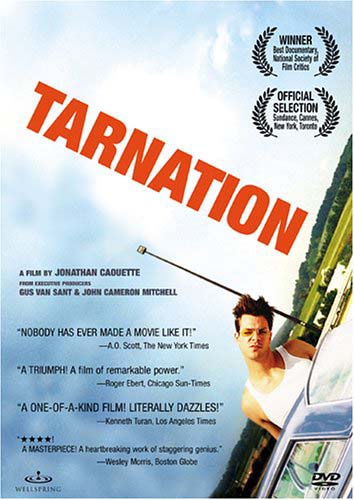 Synopsis: Tarnation is Jonathan Caouette’s dark autobiographical film, which draws on home movie footage, phone messages and conversations with family members to recount his abusive childhood and his awkward relationship with his mentally ill mother, who herself was a victim of abuse. The film follows her losing battle to stay sane, and the filmmaker’s struggle to face his own fear that one day he too may suffer the same fate.
Synopsis: Tarnation is Jonathan Caouette’s dark autobiographical film, which draws on home movie footage, phone messages and conversations with family members to recount his abusive childhood and his awkward relationship with his mentally ill mother, who herself was a victim of abuse. The film follows her losing battle to stay sane, and the filmmaker’s struggle to face his own fear that one day he too may suffer the same fate.
Structure: While this is a chaotic film, filled with disturbing and repetitive visuals, there is definitely a structure that propels the film forward. The film opens in New York, where Caouette establishes that he’s gay in the opening scene of the film by showing himself chilling with a male lover. Then he learns his mom has overdosed on lithium, which launches him on a trip to Texas to be with her. While on the trip, he uses footage of the passing landscape to begin flashing back to family footage from much earlier years. He uses a final transition in which the present-day passing landscape becomes pixelated and dissolves into the old family footage and we pull back out of an old TV where we find ourselves in his disturbing past. The film follows a mostly linear progression from the time of his childhood and catches up with the point where the film opens, then continues briefly past that to the present day, concluding with Caouette finally making an appearance as narrator speaking to the camera, giving voice to his fears.
Cinematography: This was an extremely low budget film. According to the film’s IMDB entry, it cost just $218 to make this film, but cost $400,000 to license the music and video clip royalties. But the fact that the quality is crap adds to the nature of the story, which is about someone whose life is pretty crappy. The footage looks super saturated and in many places solarized throughout the film, which helps it look stylized intentionally, rather than just plain low-quality. Stills and moving images are freely and frequently mixed together and that works well.
Editing: This film was edited on iMovie. It uses an array of simple editing tricks to create a sense of dislocation and disassociation. Highlights are blown out, pictures zoom in and out and multiply, and characters seem to disappear into mirror reflections of themselves, as if being turned in a kaleidoscope. There’s a long sequence of still photos early in the film that show Caouette’s early childhood, and they simply “flash dissolve” one after another (that is, one picture gives way to the next by quickly fading up to white, and down to the next image).
There is HEAVY use of text to narrate the story, and despite my general aversion to narration in films, I found myself wondering whether narration would have been a better choice. We learn later in the film that the filmmaker doesn’t trust himself to let go in front of the camera, which explains the awkward and repeated use of text to move the story forward.
Music and Audio: Lots of music in this film (which explains why it cost $400k to get all of it released) playing in the background while an endless number of quickly cut stills and short clips play on the screen. Lyrics like “I fell down the stairs, I wished you were dead, he handed me your head…” support the mood of the film. One nice audio transition that I’ve heard before: a sudden change of scene behind which a sound like a plane landing that is suddenly cut off as the volume rises. I want to find a sound effect for that and use it somewhere some day. There’s a nice found music edit which begins with a scene in NY subway where a street artist is singing. The visuals quickly move on to something else, but audio stays with the street performance for awhile. Great reminder to keep that camera rolling on stuff longer than you think you’ll need it – and remember that the camera is basically a rape recorder, too, even if you’re not getting any visuals at same time.
This film was a huge hit at festivals from Canne to Sundance, not because of it’s technical prowess, but because it is an authentic story told in the way only this filmmaker could tell. The subtitle for the film is also an important message to documentary filmmakers looking for ideas: Your greatest creation is the life you lead.
Here’s a really great in-depth interview with Caouette about how this film was made.